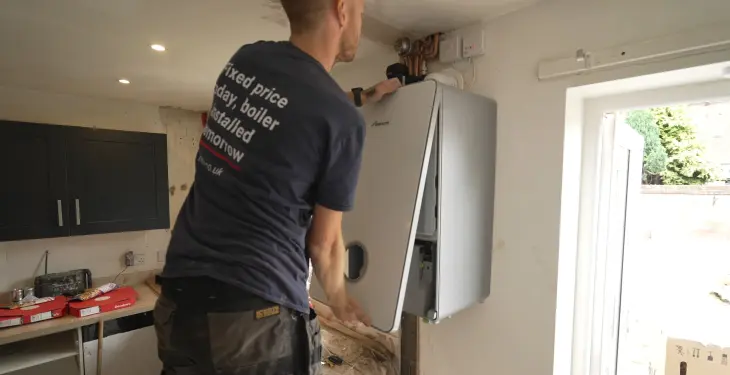

Written by Stephen Day
Gas Safe Engineer
Updated: 30th May, 2025
Thermostats are devices used to control the heating or cooling of a home. They function by sensing the current temperature and activating systems to maintain a set temperature.
Get a new boiler quote, save up to £550 per year (0% APR available).
As winter sets in, finding the right balance between comfort and energy efficiency is key. People often wonder, what is the ideal temperature for a thermostat in winter? Experts recommend setting your thermostat to around 18°C to 21°C when at home. This range is considered comfortable for most people while also promoting efficient energy use.
Thermostats are simple yet vital tools in managing home heating during the colder months. By understanding how thermostats work, individuals can make the most of their heating systems, reducing energy bills without sacrificing warmth. Simple adjustments and settings can make a noticeable difference in your home's comfort and energy consumption.
Efficient heating is about more than just setting a comfortable temperature. Learning how to manage heating when away and exploring energy-saving tips can lead to significant savings. Smart home devices offer modern solutions to optimise heating, ensuring that your home stays warm without overspending on your energy bill.
Get a quote in 60 seconds, fitted as fast as next day!
0% APR finance available.
Thermostats are devices used to control the heating or cooling of a home. They function by sensing the current temperature and activating systems to maintain a set temperature.
There are various types of thermostats, including digital and non-digital models. Non-digital ones use simple switches to control heating or cooling modes and the circulation fan, adjusting settings based on user input.
Digital thermostats, on the other hand, use sensors to monitor room temperature. They can automatically send signals to heating or cooling systems when adjustments are needed to maintain the desired environment.
A common component in some thermostats is a wax element. When heated, the wax melts and expands, pushing a metal needle that switches the system on or off.
Energy efficiency tips: Set your thermostat to the lowest comfortable setting in winter to save energy. A programmable thermostat can automatically adjust the setting, reducing energy use when you're away or asleep.
Many modern thermostats also connect to smart home systems. These smart thermostats learn user habits and adjust settings intelligently, potentially offering further energy savings.
In summary, whether for comfort or energy savings, thermostats play a crucial role in managing a home's climate effectively.
During winter, setting the right temperature for your home can help maintain comfort and energy efficiency. The Energy Saving Trust suggests keeping your home between 18°C and 21°C.
The World Health Organisation (WHO) recommends 18°C as ideal for healthy individuals wearing appropriate clothing. This temperature is also suitable for sleeping, ensuring a restful night.
Anthony Carrino, a home renovation expert, advises a setting of around 20°C for most homes. It balances comfort and energy savings effectively.
Here's a quick guide:
18°C: Ideal for healthy adults.
20°C: Comfortable for children and elderly.
21°C: For higher comfort, especially in living rooms.
Adjustments may be needed for specific preferences or home conditions. Layering up clothing is a more energy-efficient way to stay warm. Higher temperatures can increase energy use and costs, so consider your household's needs when setting the thermostat.
Staying warm in winter while keeping energy bills in check can be a challenge. Here are some practical tips to help you achieve both.
Use a Programmable Thermostat
Setting a programmable thermostat allows control over your home’s heating schedule. Lowering the temperature by a few degrees at night or when away can result in significant savings.
Loft Insulation
Heat rises, and without proper insulation, much can escape through the roof. Investing in loft insulation can prevent heat loss and keep the home warmer for longer.
Seal Drafts
Check windows and doors for drafts and seal any gaps. Simple solutions like draft excluders and weather stripping can be effective in retaining warmth.
Curtains
Heavy curtains can help keep heat inside. Closing them at night or when it’s particularly cold outside can make a noticeable difference.
Wear Layers
Encouraging the wearing of multiple clothing layers can help keep individuals warm indoors, reducing the need for higher thermostat settings.
Efficient Heating Systems
Modern, energy-efficient boilers or heaters consume less energy. Consider upgrading if your system is outdated.
Warm Bedding
Use thick blankets or duvets to stay warm at night. This way, you may be able to lower the heating without feeling cold.
Sunlight Utilisation
Opening curtains during the day allows sunlight to warm up rooms naturally. It’s a free and simple way to increase warmth indoors.
Incorporating these tips can help make your home more energy-efficient and comfortable during colder months.
When you're planning to be away during winter, managing your home’s heating efficiently can save energy and protect your home. Leaving your heating on at a low setting can prevent pipes from freezing and keep the house at a stable temperature.
It’s recommended to set your thermostat to a lower temperature rather than turning it off completely. Keeping it around 12°C is a good rule of thumb to maintain basic warmth.
Below is a simple guide for setting your thermostat when you're away:
Healthy adults: 15°C to 18°C
Elderly or babies: 18°C to 20°C
Benefits of Maintaining a Low Temperature:
Protects plumbing from freezing.
Prevents mould by keeping dampness at bay.
Eases the process of warming up the house upon return.
For efficient heating management, consider installing a smart thermostat. These devices allow you to adjust the temperature remotely, providing flexibility and control over your home environment.
Lastly, closing curtains and sealing draughts can help retain heat. Simple steps ensure energy savings and a warm return home.
Changing the thermostat setting can impact comfort and energy bills. During the winter months, many people wonder what the right temperature should be.
Optimal Temperature:
For healthy individuals, 18°C is often suitable.
Families with infants or elderly members may prefer 20°C for added warmth.
Some experts recommend 20°C as an efficient setting for both comfort and savings.
Efficiency Tips:
Night-time: Lower the thermostat slightly at night to save energy. For instance, between 58°F and 63°F can be comfortable yet economical.
When away: Turning the thermostat down while the home is empty helps in reducing heating costs.
Thermostat Settings in Various Conditions:
Situation | Recommended Temperature |
Regular use | 18°C to 20°C |
Night-time | 14°C to 16°C |
If away | 10°C to 12°C |
Smart Thermostats:
Smart thermostats can learn your schedule and adjust settings automatically. This ensures a balanced temperature, maintaining comfort while enhancing energy efficiency.
These guides serve as a basic reference. Adjusting settings based on personal comfort and weather conditions can also help in finding the perfect balance.
Seal Draughts:Small gaps around doors and windows let cold air in and warm air out. Use draught excluders or weather stripping to seal these gaps.
Adjust Your Thermostat:Consider lowering your thermostat by a degree or two. Setting it to around 20°C during the day and lower at night, like 18°C, can save on your energy bill.
Insulate Your Home:Make sure lofts and walls are properly insulated. Good insulation traps heat and keeps your home warmer, requiring less energy for heating.
Use Thick Curtains:Thick, lined curtains can block out cold air. During the day, open them to let in natural sunlight and warmth. At night, close them to retain heat.
Maximise Radiator Efficiency:Place foil behind radiators to reflect heat back into the room. Also, make sure radiators aren’t blocked by furniture. This ensures they heat the room effectively.
Utilise Smart Thermostats:Smart thermostats learn your habits and adjust the temperature accordingly. They can lower the temperature when you’re not home, reducing energy usage.
Maintaining your home efficiently makes it more comfortable and cost-effective. These simple measures can result in noticeable savings.
Investing in smart home technology can effectively reduce heating costs. Smart thermostats are a great place to start. They learn and adapt to daily routines, adjusting the temperature when needed. This feature helps optimise energy use, potentially leading to noticeable savings. Brands like Nest and Tado are worth considering.
Smart thermostats do more than just automate settings. Many offer remote access via smartphone apps. This lets users change settings while away from home. It means they can ensure the heating isn’t running unnecessarily, further cutting costs.
Another option is smart radiator valves. These allow precision control of individual radiators in different rooms. By setting specific temperatures for each room, homeowners can avoid heating areas that aren’t in use. This zoning capability enhances efficiency and reduces unnecessary energy use.
Homeowners should also think about smart meters. These devices provide real-time data on energy consumption. With this information, users can make informed decisions about their heating habits, spotting where reductions can be made. Understanding energy use is key to making effective changes.
Incorporating smart blinds or curtains can improve energy efficiency too. These devices automatically adjust based on time of day or sunlight levels. By trapping heat inside during winter, they lessen the load on heating systems.
Smart home technologies not only promote energy efficiency but can also improve comfort. They offer a modern solution to managing heating costs in a user-friendly way.
Buying a new boiler can be expensive. There are many ways to spread the cost. Understanding your options can make a big difference.
Government Grants: The government offers grants to help people replace boilers with heat pumps. These can help cover some of the costs. Check if you're eligible and how much you can get.
Council Support: Some local councils provide grants or interest-free loans. These are for residents upgrading to energy-efficient systems. Contact your council to see if they offer support.
Boiler Financing Options: Many companies offer financing plans. This allows you to pay monthly instead of all at once. Remember, most financing options require a credit check. British Gas, for instance, acts as a credit broker to arrange loans.
Personal Loans: Getting a personal loan is another way to pay for a new boiler. Compare interest rates to get the best deal. This option also involves approval processes, including credit checks.
Along with these options, consider saving money on heating bills to help with overall costs. By exploring these payment methods, replacing a boiler can be much more manageable.
To ensure your boiler runs efficiently in winter, check its flow temperature. Set the flow temperature between 60ºC and 70ºC. This range is optimal for warmth and energy efficiency. A temperature that is too high or too low can waste energy or not heat your home properly.
Pay attention to room thermostat settings. Keep the room temperature between 18ºC and 21ºC. These temperatures provide a comfortable environment without excessive energy use. Adjust your thermostat based on personal comfort and outside weather conditions.
Regular boiler maintenance is essential. Schedule annual service to inspect and clean the boiler. A well-maintained boiler operates more efficiently and has fewer breakdowns. Make sure to check for any warning signs, like unusual noises or leaks, which could indicate a problem.
Monitor heating patterns using a smart thermostat. A smart thermostat can track energy use and suggest temperature adjustments. It helps in managing heating more effectively, reducing unnecessary energy consumption.
Check your insulation. Well-insulated homes require less heat to stay warm, allowing your boiler to work more efficiently. Inspect your home for drafts and seal any gaps to maintain heat indoors.
Managing home temperatures efficiently during winter can lead to significant energy savings and increased comfort. Here are some key tips to optimise thermostat use:
Install a Smart ThermostatSmart thermostats can adjust the temperature automatically based on your habits. They enable remote control through a smartphone, allowing for easy adjustments even if you're not at home. This can help in maintaining optimal temperatures while saving on energy costs.
Lower the Temperature When AwayWhen the home is empty, reduce the thermostat setting by a few degrees. This simple action can cut heating costs significantly without sacrificing comfort when you return.
Keep Doors and Windows SealedMaking sure doors and windows are sealed tightly can prevent drafts. This stops heat from escaping, allowing the heating system to work more efficiently. Even small gaps can lead to significant heat loss.
Regular MaintenanceEnsure regular maintenance for your heating systems. This includes changing filters every few months and getting the furnace inspected annually. Well-maintained systems are more effective and can save on repair costs in the long run.
Use a Consistent SettingTry to maintain a consistent temperature setting throughout the day and night. Sudden increases can strain the heating system, leading to higher energy use.
Implementing these strategies can lead to better heating control in winter, helping to balance comfort and energy efficiency.
Get a quote in 60 seconds, fitted as fast as next day!
0% APR finance available.
Last updated: 30th May, 2025

Written by Stephen Day
Gas Safe Engineer at iHeat
Stephen Day is a Gas Safe registered and FGAS certified engineer with over 20 years of hands-on experience in the heating, cooling, and renewable energy industry, specialising in boiler installations, air conditioning, and heat pump systems.
LinkedInArticles by Stephen Day are reviewed by iHeat’s technical team to ensure accuracy and reliability.

22nd December, 2025
Based on data from over 7000 boiler installations completed by iHeat in the past 12 months...
 Read Article
Read Article

22nd December, 2025
Here’s a quick roundup of the best combi boilers for 2026.
 Read Article
Read Article

22nd December, 2025
When your old boiler breaks down and it comes time to replace it with a new one, it might...
 Read Article
Read Article
No obligation. Takes less than 60 seconds.